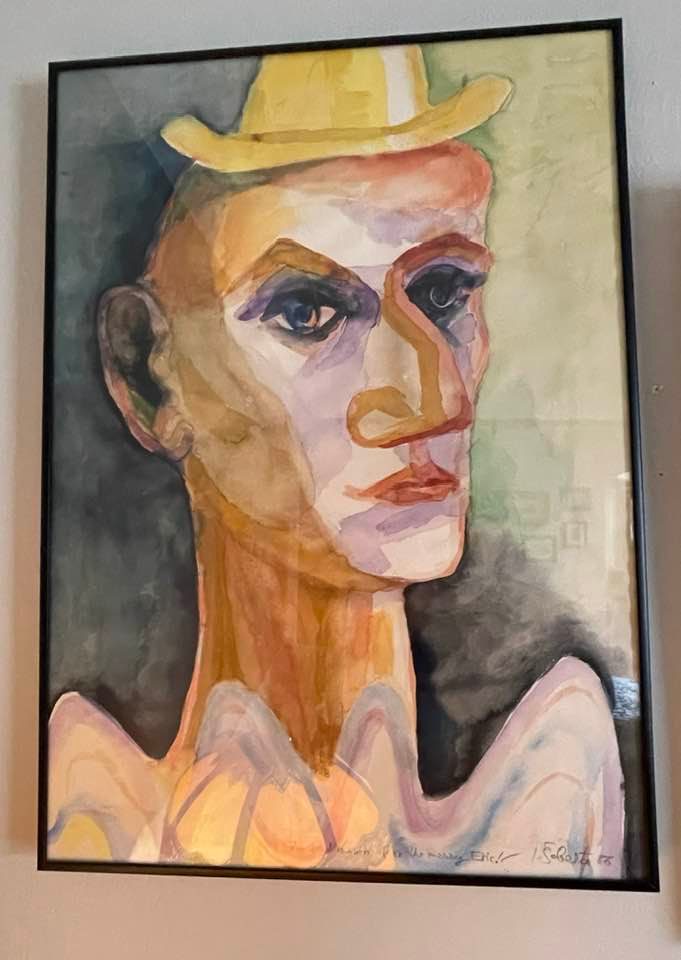MARCH 22, 2022 – Hanging on the wall of the reading room of our house is a prized possession: a large, framed watercolor portrait by Pavel’s father. The subject is a stylized, sober clown with large, penetrating eyes. Inscribed across the bottom (in English) are the words, “The Sad Clown for the Merry Eric!!”
Both the painting and the inscription captured what I observed about my Czech friends before the break-up of the Soviet Empire: they resided physically and figuratively in the most Western outpost of the Soviet Bloc and shared a mindset as informed by the West as was my own perspective . . . but in their embrace of liberal Western values, symbolized by their foot-loose-and-fancy-free American guest, my friends were also sad and angry; frustrated by chains and shackles anchored deep inside the Kremlin. Such opposing moods as “sad” and “merry” found expression in every conversation.
Would that Czech history be as simple as, “West vs. Communism.” As I soon learned, however, the German occupation during WW II factored almost as prominently in my friends’ collective mindset as did the current Soviet domination. On the occasion of the “reunion dinner” (see yesterday’s post), Pavel’s father pointed to the courtyard below where he remembered seeing German soldiers in WW II and Soviet soldiers in 1968 and said, “J’ai tout vu!” (“I’ve seen it all.”)* Before WW I, Czechs had existed in the sickly Austro-Hungarian Empire, often as second-class citizens. Through earlier centuries—all the way to Paleolithic times, when settlement of what is now Prague occurred—Czechs had been whipsawed by secular and ecclesiastic wars and friction, largely because they resided at the crossroads of Europe.
The Slovaks, meanwhile, were another whole story.
Czechoslovakia, which is the country I visited in 1981** (both the Bohemian—Czech—part and the Slovak side), had existed free and independent of surrounding powers only during the inter-war period of the 20th century. During those two decades the country enjoyed impressive gains in material prosperity and progressive self-government.
For the five days I was in Prague, Pavel and Magda whisked me around to myriad points of interest—historical and contemporary—in the city and beyond. We explored castles and museums; visited shops and parks; sampled cafes and restaurants; attended Smetana’s opera, The Merry Widow—at the Smetana Theater; relaxed at the “summer cottage” of Magda’s parents—located in a small but bucolic setting in the heart of Prague urbanity. Throughout our tour, Pavel and Magda talked. As an eager listener—and Westerner—I was a sounding board for the expression of pent-up frustration.
As we ripped around town in their old Škoda, Pavel and Magda would point out places where the German occupiers and their Russian successors had committed unforgivable crimes of violence. After a time, I started keeping score, and it was a tie between the two tyrannies. I finally asked, “You seem to harbor bitter hatred toward both Germans and Russians—but I’m curious, which do you dislike the most?”
“The Germans,” said Pavel.
“And why is that?” I asked.
“Because they gave us the Russians.” (Cont.)
_________________________
* He then showed me a collection of large, high-resolution photos he’d taken of the Soviet invaders. Incensed by their brutish force, he cast caution aside and took one amazing close-up after another. It’s a wonder he didn’t pay a heavy price.
**I visited again in 1982 and with my wife and in-laws in 1985—four years before the Berlin Wall came down. Coincidentally, we were joined by one of my Swedish cousin who, as an economist, was participating in a UN conference in Prague.
(Remember to subscribe to this blog and receive notifications of new posts by email.)
© 2022 by Eric Nilsson
